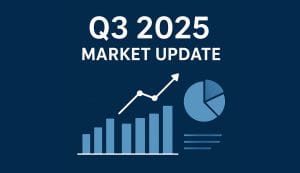The sun continues to shine on the stock markets. When will it end?

What a year it has been to date as the stock markets particularly in North America continue to hit new highs and the question I am getting lately is “when will it end”? Investing when stock markets are at all-time highs can feel intimidating. Many investors wonder whether they’re buying at the peak, only to see a correction or crash right around the corner. While it’s natural to feel cautious in these situations, history shows that markets reaching new highs are often a part of long-term upward trends. Let’s look at how to make smart investment decisions when the market is at its peak.
Stay Focused on Your Long-Term Plan
The most important rule of investing, whether the market is at all-time highs or lows, is to stick to your long-term plan. Markets will go up and down, but investing with a time horizon of five, ten, or even twenty years allows you to ride out volatility. If your investment strategy is solid and aligns with your financial goals, there’s no need to change it just because the market is at a high.
For long-term investors, market timing—trying to predict and capitalize on short-term price movements—usually does more harm than good. While it’s tempting to try to sell at the top and buy back after a dip, studies show that missing just a few of the market’s best-performing days can significantly hurt your overall returns. Instead, keep contributing to your portfolio regularly through dollar-cost averaging, which helps mitigate the impact of market volatility.
Diversification Is Key
When markets are at all-time highs, the team and I continue to evaluate the diversification of your portfolio. If a few stocks or sectors have driven much of the recent market gains, your portfolio might have become overly concentrated in those areas. This can expose you to unnecessary risk if a correction hits those sectors.
A well-diversified portfolio, spread across different asset classes like equities, bonds, and commodities, can provide a buffer against market downturns. Within the equity sleeve, we look at diversifying across industries and regions. U.S. tech related stocks have been the stars of the recent rally and we looking at other regions or sectors that haven’t soared as much but still offer strong fundamentals. International equities or sectors like consumer staples and healthcare can add stability when high-growth sectors cool down.
Consider Valuations
One key factor to watch when the market is at a high is stock valuations. What you pay matters and while a rising market isn’t inherently a bad thing, it’s important to ensure you’re not overpaying for growth. High valuations, as measured by price-to-earnings (P/E) ratios or other metrics, can signal that stocks are becoming overpriced. This doesn’t mean you should avoid the market entirely, but it does mean being selective about where you put your money.
We are always looking for companies with strong earnings growth, solid balance sheets, and competitive advantages that justify their valuations. Value stocks, which tend to trade at lower P/E ratios, can be attractive when growth stocks seem overvalued. Dividend-paying stocks can also offer more stability and income in times of market uncertainty.
Keep Some Dry Powder
When markets are at their peak, it can be wise to keep some cash on hand. This doesn’t mean moving entirely out of the market, but having a cash reserve can give you the flexibility to take advantage of buying opportunities if a correction does occur. As your stewards, we are able to “take some money of the table” so to speak and trim some gains to build up the cash required. A well-timed investment during a market dip can significantly enhance long-term returns. This is similar to what we did back in March 2020 as Covid-19 caused uncertainty and opportunity but this is only possible if you have liquidity available.
Final Thoughts
Investing at market highs doesn’t have to be a cause for alarm. We are here to ensure that you stay disciplined, stick to a diversified your portfolio with investments that are mindful of valuations. Maintaining a long-term perspective and having a cash buffer can help us navigate future market volatility while still capturing potential gains.
Article written By: Duane Francis
Posted in The Francis Forum







